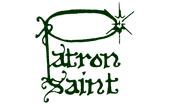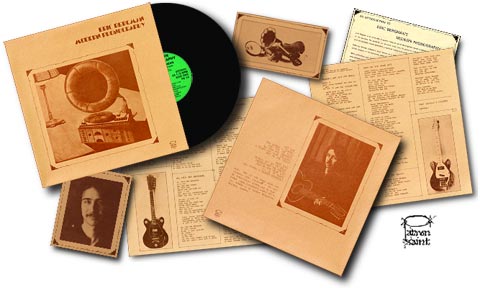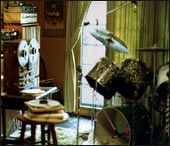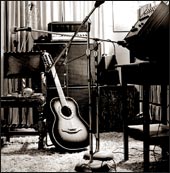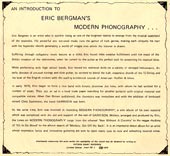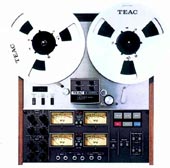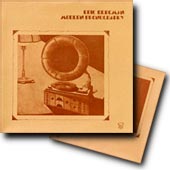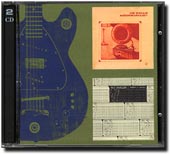


|
My first solo album, Modern Phonography, was released in May, 1978. To recap the timeframe: as tensions within Garrison grew in the fall of 1977, we finally disbanded over how we should split the costs of rented equipment. So during this "hiatus," I hatched a new, yet familiar, plan: I was going to record a solo album. Since I already had a number of my songs in various stages of completion ready to use from the aborted Garrison album, I took three of those and recorded six new ones from scratch for Phonography.
|
|
|
At the beginning, I really wanted to cut off my Garrison ties and do the album all by myself. To that end, I bought a fairly respectable set of drums from a local ad in November of 1977. And so, in the ever-continuing tradition of Fohhoh Bohob, I set them up in the living room of the house I was living in at the time. I was a passable drummer, so what the hell, I'd do that myself, too! Bit by bit, I added various pieces of recording equipment to the setup. I wasn't quite sure where I was going with all of it, but I stocked up just the same. I was heavily into still photography back then, and I read Modern Photography magazine avidly. One day, the idea of changing "Photography" to "Phonography" hit me; I wasn't even sure that it was a real word, but it certainly sounded good! As soon as I had the album title nailed down, I came up with the cover idea of having an old-time phonograph horn attached to a state-of-the-art electronic base. Since I had a limited (read: "no") budget, I knew that the cover, like Bohob's, had to be cost-effective. I figured that using only one color on a one-piece folded cover with inserts might be fairly affordable, so I went with that concept and sketched out a "proposal" for the package in January, 1978. You can see the prototype for the Patron Saint logo here as well, at the bottom right of the proposal. At the time, I felt more secure having a real artist translate my chicken-scratchings into something more professional looking, so I contacted a friend of a friend who I knew could do the job: Cin Abney Tiedeman. Cin was appropriately psyched to do an album cover, so we worked up a deal, and she started to work. I handed her everything I had come up with to that point and turned my focus back to the recording. |
|
|
I had already decided to use One For The Road, All Men Are Brothers and It's In De Blood from the Garrison sessions for the album. Blood was already complete, having been the flip-side of our single; the other two were almost done. I went through various other songs I'd written, some new, some older, and picked the ones that I thought would work well together. I worked on the "drumless" songs first; I really couldn't face having to try my hand at drumming until I had to! In the somewhat cluttered mess you see to the left, I finished up One For The Road, and recorded A Penny For Your Thoughts and Magnolia And The Mayfly, both old chestnuts that I had resurrected for Phonography. Engineering the album myself was a mixed blessing; on one hand, it allowed me complete control over my "vision," but on the other, it was a complete pain in the butt to have to start, stop, rewind and cue up tape decks after every aborted take. Slowly but surely, I finished the "acoustic" numbers; the time had finally come for me to deal with the drumming issue. Side two of the album was to start off with Monkey, Get Off My Back, a fairly vitriolic anti-paean written about Garrison drummer Joe Ivins. Although I had successfully vented my musical spleen, I was left with an interesting dilemma; Joe was the only drummer I knew who could play the song the way that I wanted it played! As fate would have it, we saw each other somewhere, mended fences and decided to work together on the album. The fact that I had written Monkey about him didn't bother him one bit. I think he was rather amused by the whole thing; he even had to agree with some of it! We combined his drums with my drums (you can see my black pearl toms and Joe's white pearl tom in the top left studio photo) to make a "super set," and worked on recording levels. From there, we laid down the bottom tracks for Monkey, Get Off My Back, Man Without A Country and Ripe On The Bough, which I finished off later. The version of Hold On For Dear Life used on the album was actually the original demo I had made of the song. For better or worse, I couldn't imagine recording a better, more emotional rendition, so I didn't bother trying. |
|
|
Meanwhile, Cin was busy working on the cover artwork. At left, you can see her working on the back cover portrait of me in February of 1978; I had given her a bunch of photos of me for her to work from. By this time, I had figured out the track sequencing of the album, so I was able to deliver all of the lyrics and rough timings so that she could start to work on the lyric sheet. I had photographed my two custom-designed guitars for inclusion on the insert; my electric 12-string graced side one and my electric Telecaster hybrid was on side two. P(atti). Lynn Radok had taken the photo of me for the inside cover flap, so that was ready to go. For some reason, I thought it would be clever to write a promotional 'introduction' to the album, which would be included as an insert. So Dan Brown and I sat down and wrote the biggest piece of hype-laden hogwash we could come up with. It still embarrasses me to read it, but here it is anyway: | |
|
As the various pieces of the packaging puzzles sorted themselves out, I turned my attentions once again to the recording process. |
|
|
With the assistance of Joe, P. Lynn, the indefatigable Dan Brown, my brother Tom, Chris Suchmann and assorted Ivins family members, I massaged each song until I was satisfied with it. The next hurdle was mixing them down to their final form. I had recorded the album using the same technique as The Beatles had used on Sgt.Pepper, which was to lay down the bottom tracks on a 4-track reel-to-reel tape deck, mix that down to another 4-track deck, and then mix the resulting concoction down to a 2-track mastering deck. Since I didn't have access to such a beast, I rented one, along with a professional reverb unit and a bigger sound board. As I remember, I got a special weekend price, so that's how long it took me to do it! Very economical. So, after editing and sequencing the cuts, by the middle of February, 1978, Modern Phonography was finished. Cin was now able to finish up the lyric sheet and fill in the missing track times on the cover, and it was off to DeSalvo-Wayne printers in Mount Kisco, New York. |
|
| Even though the liner notes state that the album was "mastered through the auspices of Charles Cameron," it isn't true. Chuck Cameron had assisted with the mastering of Fohhoh Bohob back in 1969, so I immediately thought of him for Phonography. Unfortunately, the first test pressing from the masters made by the company he dealt with was horrendously bad; the channels were reversed, it had pops, clicks and thumps and it had all of the fidelity drained out of it. Needless to say, I didn't accept it and had to bite the financial bullet and go somewhere else. I ended up using RGH Record Manufacturing instead. The Manhattan-based company was great to deal with and did a wonderful, cost-effective job. By this time the album covers had already been printed, so I wasn't able to put them in the credits...until now! Before they pressed the 500 copies I had ordered, I designed a label based on the font used on the cover of Modern Photography with the Patron Saint logo. It turned out to be a lot more expensive to generate than the stock offerings, so I settled for simple black type on a light green background with no logo, just like the Garrison single. At least it had some sort of label! | ||
Finally, in May of 1978, all of the different elements finally came together. The records arrived and, with the printed covers and inserts, I was able to hand-assemble all 500 albums, just as I had done for Bohob. Apparently, some things never change. This time, however, I found a place to shrink-wrap them. When that was all done, I was left with that nagging dilemma once again...what the hell do you do with 500 albums? Well, I gave away a lot, sent some to record companies and radio stations, sold a number in local record stores, saved some...I can barely remember now. Garrison reunited briefly (under the uncomfortable name Eric Bergman and Garrison) to promote it. Ultimately, Phonography somehow found it's way around the world, and, just like it's older brother, Fohhoh Bohob, developed an international fan base, straight from the living room! |
||
Twenty years to the month after the initial release of Modern Phonography, the CD reissue finally shipped. The set, which also contains the CD debut of my second solo album, Sending Out Signals, contains all of the original tracks from both LPs, as well as a number of selected bonus tracks. These include original and early demo versions of a number of the songs on both albums, unreleased demos, studio and live tracks, with some featuring The Patron Saints and Garrison. The package contains all of the original artwork for both albums, and all of the cuts were digitally transferred directly from the original master tapes, so at last, everything finally sounds the way it was supposed to without any vinyl-induced hiss, pops or clicks. |
||
